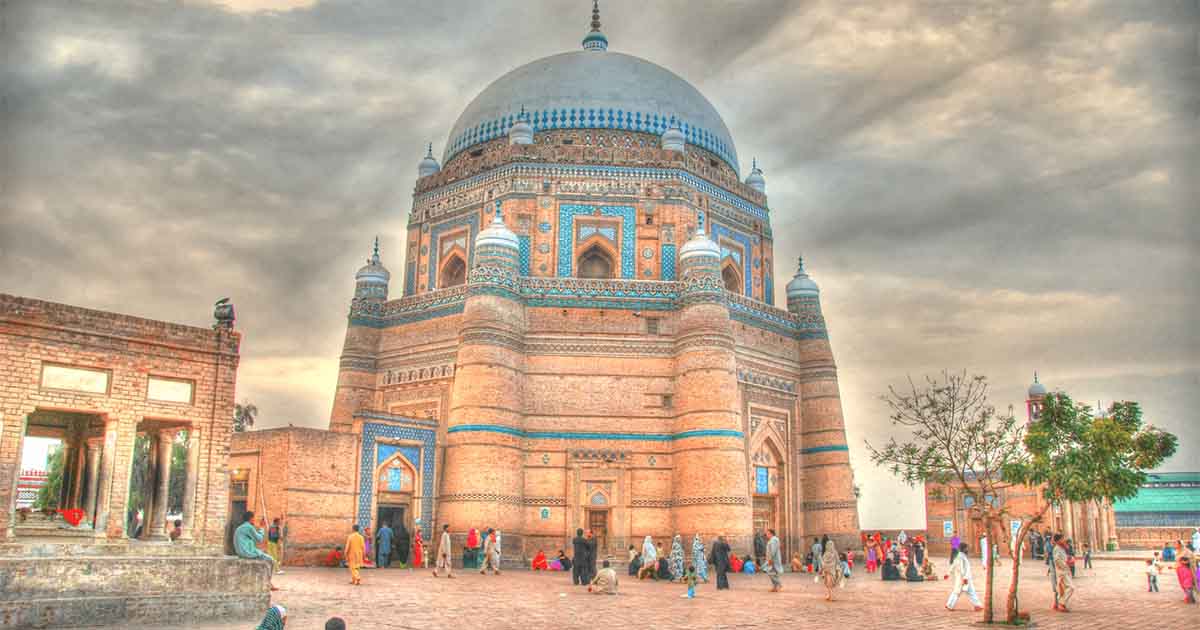MULTAN: With historical connections that unlock mysteries about the past, Multan’s rich archeological and cultural legacy dates back thousands of years, and the city has been a source of pride for generations.
It was formerly known as “the City of Gold” and “the City of Saints,” but in June 2011 it was acknowledged as Rome’s sister city, standing tall among its peers with all of its traditional and spiritual essence.
Hundreds of mausoleums of saints who spread Islam over the subcontinent with a message of brotherhood, love, peace, tolerance, and religious harmony may be found within a 25-mile radius. These mausoleums are known as “Madeena-tul-Olya.”
However, as time went on, many of the hundreds of shrines located in the city and suburbs were destroyed or damaged as a result of urban growth.
Three thousand to four thousand magnificently intact shrines are still frequented by people of many creeds for spiritual purposes, according to the Auqaf Department.
According to a senior Auqaf Department official, “the most often visited shrines include well-known Hazrat Sheikh Bahauddin Zakariya Suhrawardi, Shah Rukn-e-Alam, Bibi Pak Daman, Shah Yousaf Gardez and some others.”
Bahauddin Zakariya, popularly known as “Baha-ul-Haq,” was a notable Sufi saint of his era whose outstanding contributions led Multan to be referred to as the “Baghdad of the East.” He preached Islam to multitudes of unbelievers by traveling throughout South Punjab, winning them over to this wonderful faith.

An Auqaf Department official stated, “Hazrat Bahauddin Zakariya was not only a Sufi saint but also a great social and economic reformer.” “Thousands of devotees flock to his shrine, which houses the subcontinent’s oldest example of blue tile work.” He asserted that Bibi Pak Daman and he are credited with introducing the Suhrawardiyya order of Sufism to Multan.
The grandson and heir of Baha-ul-Haq, Shah Rukn E Alam (1251–1335) carried on his grandfather’s message. Ghias-u-Din Tughlaq created this architectural marvel for his shrine at the beginning of the fourteenth century.
When someone enters the city, they can see the tomb and its magnificent dome from a distance because it is situated atop a tiny knoll behind the old remains of Multan Fort.
“Around 2000-3000 devotees visit the shrine Thursdays, Fridays and Sundays, and 1500-2000 people during other week days,” claimed another Auqaf Department officer, Muhammad Arshad. “The department’s representatives extend a warm greeting to guests, offering them a traditional green Chaddar to wrap around their heads or necks.”
Shah Rukn-e-Alam’s grave is surrounded by graves of his successors expressing magnificent interior décor art with complex tile work coated with the plaster substance. The department of Auqaf organizes an annual three-day Urs of Shah Rukn Alam’s every year from Jamadi-ul-Awal on the 5th to the 7th.
Another saint to be worshipped is Bibi Pak Daman (c. 1170–1262). Also referred to as Bibi Rasti, she was Hazrat Bahauddin Zakariya’s pupil and the mother of Shah Rukn Alam.
She was buried next to the shrine of Mai Totla, one of Multan’s three pre-Islamic deities, when she passed away in 1295. Approximately rectangular in shape, the tomb is embellished with blue and white tiles that are characteristic of Multan, giving the impression that it has a “flat roof.”
Another stunning example of Sufism is the mausoleum of Shah Yusuf Gardez, which is located inside the walled city close to Bohar Gate. The mosque was constructed in its southern portion by Sher Shah Suri during his rule (1639-1655), while the mausoleum was constructed in 1150 AD.
Many unbelievers were won over to Islam by Shah Yousaf Gardez.

The grave of Shah Dana Shaheed, a student of the illustrious Bahauddin Zakariya, is located in the southeast of the city, northwest of Delhi Gate (1170-1262).
The Auqaf Department claims that there is a dearth of information on the lives of numerous people, including Hameed-ud-Din Hakim and Shah Dana Shaheed.
Qutab-al-Qutaab, Hafiz Muhammad Jamal Chisti Nazami, Pir Chup Wardi Waly, Hazrat Shah Dana Shaheed, Abu Hassan Hafiz Jamal-ud-din nicknamed Musa Pak Shaheed, Syed Hasan Khanjzee, Syed Pir Sakhi Shah Hassan Parwana, Mollana Hamid Ali Khan Naqshbandi, and Hazrat Shah Kamal Qadari. Hazrat Khawaja Awais Khagga, Hazrat Sakhi Sultan, Hazrat Gul Shah, and Pir Syed Wali Muhammad Shah (Chadar Wali Sarkar), whose shrines were located in desolate areas of the district.
Each year, thousands of devotees come to these locations to rekindle their spirituality and learn from their teachings.
“I have come here to pray for my son’s success in the intermediate examination,” stated Ismael, 63, who had traveled from Toba Tek Singh to the final residence of Shah Rukn-e-Alam. “We come here because we owe these religious people respect and honor.”
Scholar Safia Bibi traveled great distances from Dera Ghazi Khan to observe the shrines’ inspirational design.
With delight and amazement, she said, “It’s typical of Suhrawadi tombs with three entrances, a western-facing Mehrab and original main entrance on the southern axis.”
All year long, a large number of people flock to the shrines, especially those of Shah Rukn-e-Alam, Bahauddin Zakariya Suhrawardi, and Shah Yusuf Gerdez.
Renowned shrines designated by Dhamal and Qawwalis host annual Urs, where attendees donate hundreds of thousands of rupees for the upkeep of the shrines and the aid of the underprivileged. The services of Sufis in promoting Islam throughout the Subcontinent are also highlighted through a series of lectures given by well-known religious and Sufi teachers.





